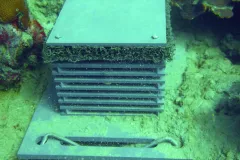A Better Way to Measure Marine Life

Collect, sort, identify, photograph, sample, record. Repeat a couple thousand times. This is what the students and researchers have been doing as the Indonesian Biodiversity Research Center (IBRC) project has seriously ramped up.
The foundation of the IBRC project is a relatively new method of sampling biodiversity, which uses Autonomous Reef Monitoring Structures (ARMS) to measure reef life. Resembling a reef condominium, each ARMS is a stack of 10 spaced plastic plates that are left on the ocean bottom for a specific period of time. Marine invertebrates -- like sea squirts, bryozoans, sponges, decapods, snails, and worms -- take up residence in the ARMS, much like they would on a coral head.
After a year, scuba divers retrieve the ARMS from the ocean floor and researchers completely take them apart. The plates are photographed and then the species are identified, recorded, and sampled for DNA processing. Using molecular techniques, scientists process the animals’ DNA to generate a genetic fingerprint for each species and place them in the tree of life.
Why is the IRBC project using ARMS? Scientists have been studying terrestrial and marine biodiversity around the world for years, but like each individual species, every scientist is different. Because the ARMS methods are standard no matter where they are used, it is possible to compare results from place to place and through time so that scientists worldwide can compare and share data.
The information about the biodiversity found on the ARMS provides scientists with a proxy for hidden coral reef life. With this, researchers can make better estimations of the overall biodiversity of specific marine systems that, in turn, helps inform their management.
Editor's note: If you really want to get a better idea of what the ARMS look like underwater, and how they get there, watch this video that shows the proper way to deploy them.

